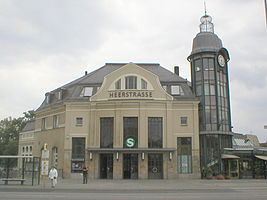Berlin Heerstrasse train station
| Berlin Heerstrasse | |
|---|---|
|
Entrance building of the station
|
|
| Data | |
| Operating point type | Breakpoint |
| Platform tracks | 2 |
| abbreviation | BHST |
| IBNR | 8089329 |
| Price range | 5 |
| opening |
November 1, 1909 January 16, 1998 |
| Conveyance | 17th September 1980 |
| Architectural data | |
| architect | Ernst Schwartz |
| location | |
| City / municipality | Berlin |
| Place / district | West end |
| country | Berlin |
| Country | Germany |
| Coordinates | 52 ° 30 '31 " N , 13 ° 15' 31" E |
| Railway lines | |
|
|
| Railway stations in Berlin | |
Heerstraße station is a S-Bahn station in Berlin . Operationally, the station is classified as a stopping point .
The stop, which opened on November 1, 1909, is on the edge of the Grunewald in the Charlottenburg-Wilmersdorf district on the suburban route to Spandau , between the Messe Süd (Eichkamp) and Olympiastadion stations . The facilities of the station, like the entire route with all bridges and train stations, are under monument protection .
history
The eponymous Heerstraße was a military parade road and later belonged to the so-called east-west axis . It was laid out from 1903 on what was then Reichskanzlerplatz (today: Theodor-Heuss-Platz ) as a connection to the military training areas in Döberitz . On the occasion of the 1936 Summer Olympics , it formed the link between the Olympic Village in Elstal and the Olympic Stadium .
The breakpoint was built in 1908/1909 on the suburban line Charlottenburg-Spandau to develop the villa colony planned there. After the station initially had a marginal existence, it was later occasionally used for state receptions due to the attractive, wide road connection to the Berlin city center. On May 11, 1925, the newly elected President Paul von Hindenburg arrived in Berlin on a special train from Hanover and was received by the Chancellor Hans Luther . On September 27, 1937, the National Socialist dictator Adolf Hitler received the Italian leader of the fascist movement Benito Mussolini with a meticulously planned production and drove with him over the martially decorated east-west axis to the Reich Chancellery .
As part of the planning for the reconstruction of Berlin into the so-called “ World Capital Germania ”, the reception building was to be demolished and replaced by a representative reception station for state guests designed by Theodor Dierksmeier - called the “Mussolini station”. These were to be routed from there via the east-west axis to Berlin, for which a monumental expansion was planned. Due to the high costs and the outbreak of the Second World War , the renovation did not get beyond the planning phase.

On the occasion of and only for the time of the Olympic Games in 1936, a provisional train station for the " KdF -Stadt" was built nearby , which was located on what is now the exhibition grounds on Wandalenallee. The numerous Olympic guests were received in the settlement made of wooden houses and received cheap accommodation and food options in the immediate vicinity of the Olympic Stadium. The temporary station was reached via a track that branched off from the ring freight tracks north of Westkreuz and led in a large arc to the exhibition center. This so-called "exhibition track" was laid out in 1928 when the railway systems were redesigned in this area and still exists today in a slightly different form.
On July 4, 1944, the reform pedagogue and resistance fighter Adolf Reichwein was arrested by the Gestapo on the way to a conspiratorial meeting with leaders of the KPD in preparation for the July 20 assassination attempt at the Heerstrasse train station .
The station building was badly damaged in the Second World War and rebuilt in 1958/1959.
At the end of September 1980, after the Berlin S-Bahn strike, S-Bahn traffic to Staaken was stopped and the stop was closed. On May 25, 1984, this station came back to life for a short time: an S-Bahn day was held on it. For the reopening of the line on January 16, 1998, the breakpoint was rebuilt again and received its current shape.
Surroundings
Opposite the reception building is Raußendorffplatz. This garden monument was created in 1925 by Erwin Barth with a simple lawn and benches.
The Teufelsberg is located between the Grunewald S-Bahn station and the Heerstraße stop .
Connection
The station is served by lines S3 and S9 of the Berlin S-Bahn. There is a possibility to change to the bus lines M49, X34, X49 and 218 of the Berliner Verkehrsbetriebe .
| line | course |
|---|---|
|
|
Spandau - Stresow - Pichelsberg - Olympiastadion - Heerstraße - Messe Süd - Westkreuz - Charlottenburg - Savignyplatz - Zoological Garden - Tiergarten - Bellevue - Central Station - Friedrichstraße - Hackescher Markt - Alexanderplatz - Jannowitzbrücke - Ostbahnhof - Warschauer Straße - Ostkreuz - Rummelsburg - Rummelsburg depot - Karlshorst - Wuhlheide - Köpenick - Hirschgarten - Friedrichshagen - Rahnsdorf - Wilhelmshagen - Erkner |
|
|
Spandau - Stresow - Pichelsberg - Olympiastadion - Heerstraße - Messe Süd - Westkreuz - Charlottenburg - Savignyplatz - Zoological Garden - Tiergarten - Bellevue - Hauptbahnhof - Friedrichstraße - Hackescher Markt - Alexanderplatz - Jannowitzbrücke - Ostbahnhof - Warschauer Straße - Treptower Park - Plänterwald - Baumschulenweg - Schöneweide - Schöneweide depot - Adlershof - Altglienicke - Grünbergallee - Berlin-Schönefeld Airport |
Web links
- Berlin Heerstraße train station on stadtschnellbahn-berlin.de
Individual evidence
- ↑ Station price list 2020. (PDF) In: Deutsche Bahn. Deutsche Bahn, January 1, 2020, accessed on July 10, 2020 .

